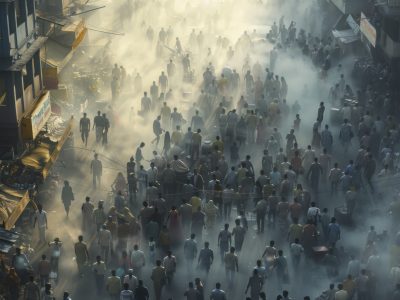Incidents of stampedes at railway stations are not new. They can be caused by various triggers, ranging from confusion in train schedules to sudden surges in passenger numbers. A notable recent example, highlighted by The Times of India, involved two trains with similar names—Prayagraj Express and Prayagraj Special—leading to confusion among travelers and culminating in a deadly stampede. This tragedy underscores the importance of robust crowd management strategies, effective communication systems, and advanced technologies to mitigate stampede risks.
This article delves into how railways around the world and disaster management can effectively deal with stampede risks. We will explore the technical, infrastructural, and operational dimensions of risk prevention, emphasizing real-world insights and modern crowd-control methodologies.
1. Understanding the Underlying Causes
1.1 Sudden Surges and Confusion
Stampedes usually occur when a large group of people tries to move through a constrained space. In the case of the Prayagraj Express and Prayagraj Special stampede, the confusion stemmed from similar train names. Passengers rushed to board the train they believed was theirs, leading to overcrowding on a particular platform. When there is uncertainty or contradictory information, travelers often panic, exacerbating crowd pressure.
Beyond train name confusion, other causes for sudden surges include:
- Last-minute platform changes leading to frantic movement.
- Train delays that compress large numbers of people onto one platform.
- Festivals or peak travel seasons increase passenger counts drastically.
1.2 Lack of Clear Communication Channels
In many rail networks, especially those handling millions of passengers daily, communication is key. Miscommunication or lack of real-time information can lead to passengers rushing en masse, increasing the chance of stampede. Critical communication failures include:
- Poor public address systems.
- Inconsistent or unclear passenger information displays.
- Staff members not trained to handle surging crowds.
1.3 Inadequate Physical Infrastructure
Older railway stations often have narrow platforms, limited exits, or suboptimal passenger flow designs. These physical constraints turn typical rush-hour crowding into a high-risk scenario if a sudden trigger causes mass panic.
2. Advanced Planning and Design Strategies
2.1 Station Design and Capacity Analysis
One of the foundational methods to reduce stampede risk is intelligent station design. Modern urban planning tools, such as Building Information Modeling (BIM) and crowd simulation software (e.g., Legion or MassMotion), allow designers to evaluate passenger flows under various scenarios. By integrating passenger volume data, railway operators can identify pinch points and areas prone to congestion.
- Wider platforms: Ensuring a comfortable passenger density range, typically below 4 people per square meter, to reduce the likelihood of “crush” scenarios.
- Multiple access points: Having more than one entry and exit path gives passengers alternatives in emergencies.
- Structured passenger flow: Using signage, lane markings, and station furniture (benches, barricades, etc.) to guide passenger movement systematically.
A well-designed station layout can significantly reduce the probability of a stampede, as it naturally dissipates crowd build-up across more space.
2.2 Zoning and Segregation
Zoning strategies help separate different passenger groups or flows. For example, if a particular platform is serving a high-demand train (such as one heading to a religious festival city), that segment of the station can be cordoned off from regular commuter traffic with controlled entry points. Such compartmentalization ensures that one overly crowded zone does not spill over to others, and station staff can focus their crowd control measures with effective risk management strategies where needed.
2.3 Flexible Infrastructure
Modular or flexible infrastructure, such as retractable barricades and variable message signboards, allows station operators to swiftly adapt to changing passenger volumes. This is crucial in cases of unforeseen disruptions like train cancellations, delays, or the arrival of a special train. If an area becomes overcrowded, staff can reroute passengers with minimal structural changes using these adjustable barriers and directional signage.
3. Technological Interventions
3.1 Real-Time Passenger Flow Monitoring
Many modern railway stations globally are investing in sensor-based systems and CCTV networks to monitor crowd density and movement patterns. These tools can track real-time foot traffic and alert station control rooms when certain areas approach capacity thresholds. Some systems employ artificial intelligence (AI) and computer vision algorithms to detect abnormal crowd behaviors, such as sudden surges or stampede-like clustering.
- Thermal cameras or infrared sensors can accurately track the number of people in a given area, unaffected by poor lighting or visibility.
- Machine learning models can learn station-specific crowd movement patterns, providing predictive analytics for potential congestion points.
3.2 Dynamic Information Displays and Public Address Systems
To combat confusion, especially confusion caused by trains with similar names, it is crucial to provide clear, real-time information. Digital signage can switch between languages, highlight train numbers in large fonts, and display color-coded alerts. The name of the train and departure platform should match across all displays, announcements, and official mobile applications.
Additionally, integrated public address systems must broadcast updates in multiple languages, especially in regions with diverse linguistic populations. Such risk mitigation systems should be designed for clarity and coverage so that even in a crowded environment, people can clearly hear critical messages regarding platform changes or train status updates.
3.3 Mobile and Online Technologies
A large proportion of today’s railway passengers use smartphones. Railways can harness mobile channels to deliver:
- Push notifications for train schedule changes or platform updates.
- Real-time train-tracking apps to reduce guesswork about train arrivals.
- Crisis alerts in the event of unexpected surges, advising passengers on alternate routes or waiting areas.
When integrated with station sensors, these applications can even predict approximate wait times and recommend less crowded station entrances.
4. Operational Measures and Protocols
4.1 Staff Training and Deployment
Even the most advanced technology is only as good as the people who manage it. Railway staff, including security personnel, station masters, and ground staff, must receive specialized training in crowd management, conflict de-escalation, and emergency protocols. Training modules should cover:
- Recognizing early signs of crowd distress or panic.
- Quickly isolating a potential problem area.
- Guiding passengers calmly and authoritatively in chaotic situations.
During critical peak times, railways can deploy additional staff to platforms known to serve popular destinations or special event trains. These staff members can help manage queues, provide immediate assistance, and ensure that passengers receive accurate information.
4.2 Crowd Control Equipment
While station design focuses on permanent infrastructure, crowd control relies heavily on portable equipment. Well-managed railways often deploy:
- Temporary barriers or rope lines to manage queues.
- Handheld public address systems for staff to give instructions in real-time.
- High-visibility vests so that passengers can easily spot official personnel.
In addition, the presence of first-aid kiosks on platforms can mitigate stampede injuries by providing immediate medical support to those who might get hurt in dense crowds.
4.3 Standardized Train Naming and Numbering
A key insight from the Prayagraj Express/Prayagraj Special confusion is the importance of clear, unambiguous nomenclature. Railway authorities could consider crowd management strategies like:
- Distinctive names and disclaimers for trains with overlapping routes.
- Color-coded train numbers displayed on LED boards for instant recognition (e.g., a green-coded number for a special train and a blue-coded number for a regular train).
- Stricter guidelines on how special trains are labeled to avoid duplication or near-duplication in both name and number.
Such clarity in naming can massively reduce the scope for passenger confusion, especially for those who might be illiterate or unfamiliar with local languages.
5. Regulatory and Policy Frameworks
5.1 Legal Mandates on Safety
Countries like Japan and Germany have stringent legal frameworks requiring rail operators to maintain passenger density below certain thresholds and to file emergency management plans. In India, where daily passenger volumes are exceptionally high, there is an increasing push toward formalizing station safety guidelines. Ideally, a central regulatory body should mandate:
- Periodic crowd safety audits for each station.
- Mandatory disclosure of emergency evacuation routes.
- Penalties for non-compliance to ensure accountability.
5.2 Emergency Evacuation Plans
In many high-capacity transit systems, emergency drills and simulations are legally required at regular intervals. This fosters readiness among station staff and police, ensuring quick, coordinated responses and lowering stampede risk. A well-developed Emergency Evacuation Plan (EEP) encompasses:
- Safe muster points clearly marked for passengers.
- Instant communication protocols between station control rooms, local police, and medical facilities.
- Role-specific responsibilities outlining which agencies or staff handle crowd movement, medical assistance, or external coordination.
6. Learning from Global Best Practices
6.1 Japan’s Efficiency Model
Japan’s railway system is globally renowned for punctuality and organization. Stations like Tokyo’s Shinjuku, one of the busiest in the world, utilize:
- Automated gates that limit passenger flow onto platforms.
- High-frequency train schedules reducing dwell times and preventing overcrowding.
- Extensive signage in multiple languages, ensuring even foreign travelers can navigate easily.
During peak hours, station staff—often referred to as “oshiya” or “pushers”—help manage passenger flow by guiding or physically assisting travelers into trains to maximize capacity without causing panic.
6.2 London Underground’s Real-Time Control
The London Underground employs a network operations center that monitors train movement, station density, and passenger flow across the system in real time. Large screens track data from hundreds of cameras and sensors, enabling staff to:
- Close station entrances when crowd levels approach unsafe limits.
- Broadcast targeted announcements for platform crowding or line disruptions.
- Provide alternate route recommendations through official social media channels and station displays.
6.3 Integration of Data and Predictive Analytics in Singapore
Singapore’s Mass Rapid Transit (MRT) system has moved towards leveraging predictive analytics. By combining historical ridership trends with real-time passenger data, they can forecast potential overcrowding events before they occur. This approach allows staff to proactively redirect passengers or deploy additional trains to high-demand routes. It also informs escalated staff allocation at specific choke points.
7. Crisis Communication and Passenger Awareness
7.1 Multiple Channels of Communication
In times of crisis or sudden disruptions, clarity is king. Railways must push consistent information across:
- Station displays and audio announcements.
- Official mobile applications and SMS alerts.
- Local radio and social media platforms.
Consistency in messaging reduces panic. If a train schedule changes or a platform gets overcrowded, uniform messaging ensures passengers receive the same instructions everywhere, minimizing rumor-driven or contradictory behaviors.
7.2 Passenger Education Campaigns
Regular passengers often become accustomed to routine commuting patterns. However, new or occasional travelers may be unaware of how to respond in a crisis. Railways can conduct public awareness campaigns through posters, short videos on station screens, or social media explaining:
- How to identify safe exits and muster points.
- What to do if crowds begin to surge unexpectedly.
- How to differentiate between train names/numbers—especially important in systems prone to similar train designations.
Such campaigns empower passengers to make safer, more informed decisions during emergencies and is an ideal part of disaster management strategies.
8. Continuous Improvement Through Data-Driven Insights
8.1 Post-Incident Audits
Following any stampede or near-stampede event, a thorough post-incident audit should be conducted. This involves:
- Reviewing CCTV footage to map crowd movements.
- Interviewing staff and passengers to identify communication breakdowns.
- Assessing whether emergency protocols were triggered promptly and effectively.
Data gathered from these audits can shape improved protocols, ensuring that lessons from each incident are systematically incorporated into future planning.
8.2 Machine Learning Models for Predictive Analysis
Railway operators can benefit from building machine learning models that correlate passenger footfall data with external factors like weather, public holidays, or large-scale events in the city. Over time, these models can “learn” to predict specific intervals where crowd density might spike. Alerts can then be sent to station managers, enabling them to deploy extra staff and implement preemptive crowd control measures.
9. The Road Ahead
9.1 Balancing Efficiency with Safety
Rapid mass transit systems will continue to be the backbone of urban mobility worldwide. The challenge lies in balancing higher capacities and minimal boarding times with passenger safety. Over-reliance on speed and volume without safety checks can invite chaos, especially in unforeseen situations like the confusion over similarly named trains.
9.2 Holistic Collaborations
No single entity can manage stampede risks alone. Effective risk management entails collaboration between:
- Railway authorities (for infrastructure and service planning).
- Local police and emergency responders (for crowd control and crisis management).
- Technology providers (for sensor networks, AI-driven analytics, and communication platforms).
- Passengers and citizen groups (for awareness, compliance, and feedback loops).
A coordinated, multi-stakeholder approach ensures redundancy in safety measures and a broader reach in crisis communication.
Stampede risks in railway systems are multifaceted, influenced by design limitations, operational lapses, and communication gaps. The tragic stampede incident involving the Prayagraj Express and Prayagraj Special highlights how something as fundamental as train naming conventions can trigger mass confusion and panic. By learning from this and other global incidents, railway authorities can implement a holistic, advanced, and data-driven approach to crowd management.
Key lessons include investing in station design that accommodates safe passenger densities, leveraging real-time monitoring technologies, and establishing crystal-clear communication channels—both within the station and across digital platforms. Training staff in crowd psychology and emergency response is equally pivotal, ensuring they can diffuse tense situations before they escalate.
Moreover, ongoing policy reforms and legal frameworks can institutionalize safety practices, holding railway operators accountable for continuous improvement. Collaboration among technology providers, local authorities, and the traveling public cements a robust safety culture, ensuring that railway stations worldwide remain efficient, welcoming, and, above all, safe.
By adopting these risk management strategies—advanced planning and design, cutting-edge technology, comprehensive operational protocols, and a strong regulatory framework—railways around the globe can significantly mitigate stampede risks and provide a secure travel experience for millions of passengers every day.















